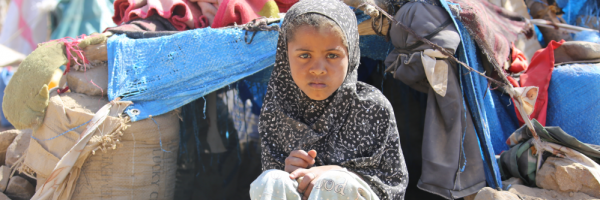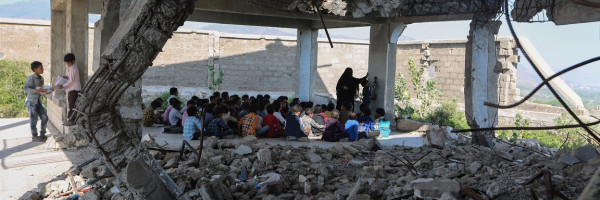Education in Crisis Situations: Partnership for Transformative Actions
Education in Crisis Situations: Partnership for Transformative Actions
Introduction
The Global Initiative – Partnership for Transformative Actions in Crisis Situations in the first global multi-stakeholder initiative to mobilize cross-country cooperation and bring actions to scale while addressing immediate educational needs at national, regional, and global levels.
As 244 million children and young people are currently affected by armed conflict, health, or climate-induced disasters, political or economic crises, and associated forced displacement, including refugee crises, the need to intervene and put an end to the vicious cycle is urgent. Crises dramatically impact the longer-term investment required to transform education systems and to ensure their resilience to future disruption.
With the main objective of advocating for and implementing the Humanitarian-Development- Peacebuilding Triple Nexus, the Global Initiative was launched as the main framework for its actions which targets 4 areas:
- Inclusive education: Improve equitable inclusive education access and learning outcomes for children and youth affected by crises.
- Finance: Protect and improve external financing, ensure it reaches learners equitably and aligns with national planning priorities and commitments to international conventions.
- System Strengthening: Build inclusive, crisis-resilient education systems that ensure protection of the right to education for children and youth, address the needs of all learners in a holistic way, and include information and tools related to safeguarding health, wellbeing, nutrition, water, sanitation and protection from violence, sexual exploitation and abuse.
- Interlinked priorities: Scale and mainstream high-impact and evidence-based interventions into policy and programming efforts with a focus on eight inter-linked priorities: (i) teachers; (ii) community participation; (iii) gender equality and inclusion; (iv) early childhood education; (v) mental health and psychosocial support; (vi) protection from violence; (vii) equitable delivery of education technology and innovation, especially for the most marginalized children; and (viii) meaningful child and youth engagement.
Strategies and activities
For the Partnership, implementing this initiative means making it relevant for those most in need, with a focus on tangible actions where it matters most: on the ground, in the classroom, and in the experience of teachers and learners alike. Moving forward is about making this Call to Action meaningful in concerned countries and thinking of its implementation based on the different feedback and contexts.
Thus, out of the 36 members who have signed off, an agreement was made to focus on the following 14 countries: Colombia, Ecuador, Ethiopia, Iraq, Jordan, Niger, South Sudan, Uganda, Yemen, Zambia.
Based on National consultations held in the 14 countries, the Operationalization plan of the Global Initiative – Partnership for Transformative Actions in Crisis Situations focuses on solutions that:
- Identifies ways to strengthen political accountability for transforming and financing education in crisis situations
- Draws the main guidelines to implement the 4 pillars of the Global Initiative
- Establishes a clear roadmap staged with milestones until December 2024.
- Map the national consultation commitments to concrete country-level actions supported by engaged EiEPC stakeholders on the ground.
- Anchor interventions to national, regional, and global monitoring and reporting mechanisms with a first status report published in September 2025 reflecting adaptations and adjustments that enable meaningful, contextualized action and monitoring.
Co-conveners
The co-conveners of the Call-to-Action: Education in crisis situations are:
- UNESCO
- UNICEF
- UNHCR
- Education Cannot Wait
- Global Partnership for Education
Partners
The Global Initiative has been signed and endorsed by the following 36 Member States: Cameroon, Canada, Chad, Denmark, Ecuador, Ethiopia, Germany, Haiti, Jordan, Lebanon, Lithuania, Madagascar, Niger, Norway, Pakistan, Palestine, Philippines, Qatar, South Sudan, Sweden, Switzerland, Tanzania, Turkey, Uganda, Ukraine, United Kingdom, Uzbekistan, European Union, ECW, GPE, UNESCO, UNHCR, UNICEF, INEE, EiE Champion Group (coalition of more than 90 CSOs), The LEGO Foundation
How to engage
The best way to engage for countries and organizations remains to endorse the CtA. Being engaged means to make a living and transformative commitment for the most in need and to fully capitalize on this unique opportunity. It must be done by:
- Nurturing and sustaining the political commitment and resources mobilized to support countries to adhere to the pillars of the Call to Action
- Engaging all stakeholders at local, national, regional, and global levels to create a movement beyond ministries of education, led by learners and teachers across the world, inspired by civil society, and connected with broader movements for positive change.
- Strengthening existing clusters and working groups on Education in Emergencies and reinforce open and effective Triple Nexus partnership platforms.
- Gathering robust data and evidence to transpose the national consultation commitments to concrete country-level actions supported by engaged EiEPC stakeholders on the ground
- Taking proactive and transformative measures to address the key barriers and bottlenecks to education in crisis situations, with a focus on the most marginalized populations.
- Accounting for progress on global, regional, and national commitments on education in crisis situations in and through education.

